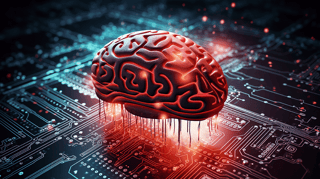The Role of Machine Learning in Winning the War Against Cybercriminals

Continue uncovering the transformative impact of Machine Learning in thwarting cyber threats and enhancing cybersecurity measures
The Digital Age of Cyber Threats Demands AI-Powered Defenses
The digital age has ushered in a golden age for innovation, but also a dark age for cybercrime. As technology advances, so do the tactics of cybercriminals, making it crucial for organizations to fortify their cybersecurity defenses.
This article explores how Artificial Intelligence (AI), particularly Machine Learning (ML), is revolutionizing cybersecurity by offering a powerful shield against ever-evolving cyber threats.
The Evolving Threat Landscape: Why Traditional Security Isn't Enough
Remember the days of dial-up internet and bulky desktop computers? Cyberattacks have come a long way since then. Today's cybercriminals are highly skilled and relentless, employing sophisticated methods like social engineering, malware, ransomware, and phishing to infiltrate systems and steal sensitive data.
These ever-changing tactics render traditional, signature-based security solutions obsolete. These solutions rely on pre-defined patterns to identify threats, leaving them vulnerable to zero-day attacks and novel malware strains.
Challenges of Traditional Security Solutions
- Limited Scope: Traditional security measures like antivirus software and firewalls struggle to adapt to the ever-evolving threat landscape.
- Blind Spots to Zero-Day Attacks: Zero-day attacks, which exploit unknown vulnerabilities, bypass traditional security measures entirely.
- Alert Fatigue: Traditional solutions often generate a high number of false positives, overwhelming security teams with alerts and hindering real threat detection.
The Adaptive Power of AI in Cybersecurity
AI, particularly Machine Learning (ML), offers a new paradigm for cybersecurity. Here's how ML empowers organizations to stay ahead of the curve:
- Machine Learning: The Lifeblood of AI Security: ML algorithms are the engines that power AI security. By analyzing vast amounts of data, they can learn and adapt over time, constantly refining their ability to detect new threats.
- Real-Time Threat Detection and Anomaly Recognition: ML algorithms continuously monitor network traffic, user behavior, system logs, and other data sources to identify anomalies that might signal suspicious activity. This allows for real-time threat detection and faster response times.
- Phishing Email Filtration with Machine Learning: Phishing attacks are a common tactic for tricking users into surrendering sensitive information. ML algorithms can analyze email content, sender behavior, and user activity to identify and filter out sophisticated phishing attempts.
- Prioritization of Vulnerabilities and Patch Automation: ML algorithms can analyze vulnerability data to prioritize patching based on potential risk. This allows security teams to focus on the most critical threats and automate the patching process, minimizing the window of opportunity for attackers.
The Human Touch: Why AI and Security Professionals are a Perfect Match
While AI offers a powerful defense, it's important to remember that cybercriminals are also exploring AI for malicious purposes. To stay ahead of this evolving threat, human expertise is crucial. Security professionals need to interpret AI insights, make strategic decisions, and oversee the overall security posture to ensure comprehensive protection.
Total Communications: Your Partner in the AI-Powered Cybersecurity Revolution
At Total Communications, we understand the critical role AI plays in safeguarding your organization in today's digital landscape. We offer a comprehensive suite of AI-powered security solutions designed to detect, prevent, and respond to cyber threats.
Learn how Total Communications can help you leverage the power of AI to build a robust and future-proof cybersecurity strategy.